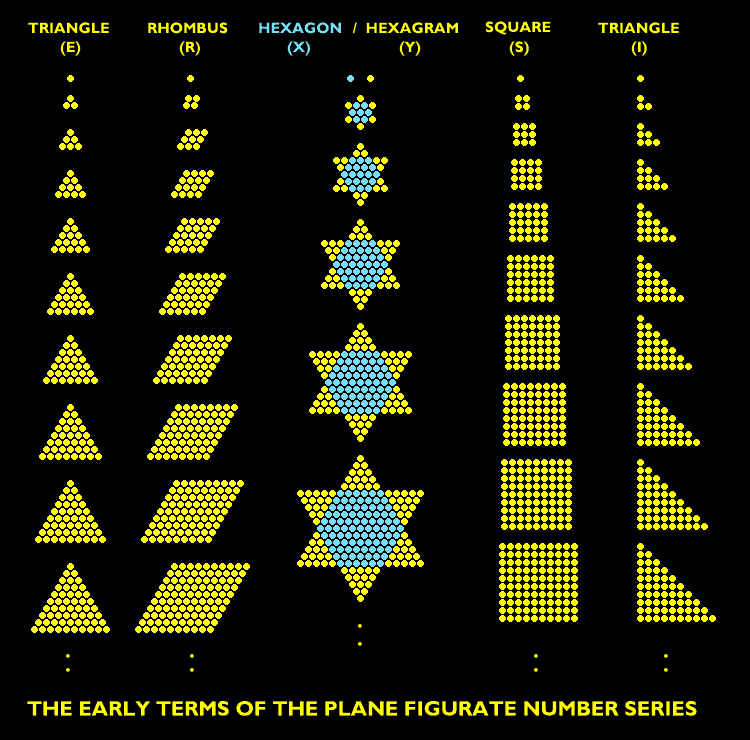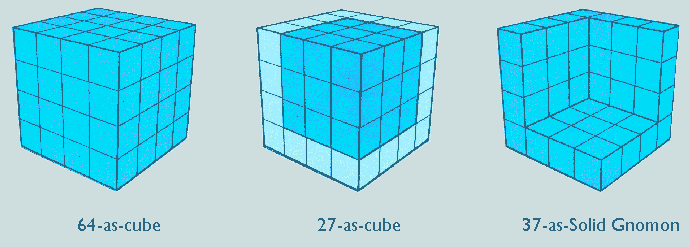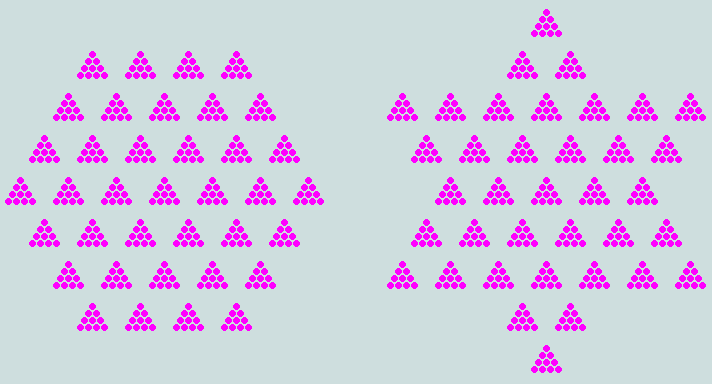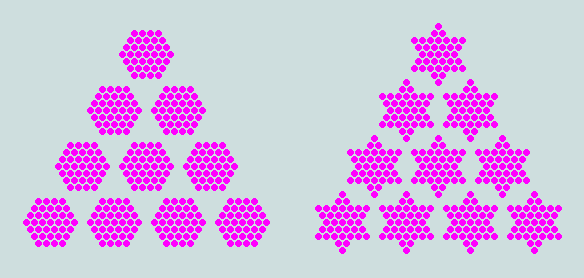
NUMERICAL GEOMETRY - A PRIMER
Preamble - From a bag of coins of the same denomination it is possible to construct a number of families of simple symmetrical shapes. Each family is called a series, and each member of a series is called a term. Associated with each term is a fixed whole number - aptly called a figurate number - representing the number of coins, or counters, required to form the characteristic shape. The first term in every case is 1. This is said to be degenerate, in that it offers no clue as to the subsequent development of the series.
Depicted below are the early terms of the 2-D, or plane, series - some of which figure in The Other Bible Code.

Clearly, in each case, the number of terms is without limit. The position of any term in a series is referred to as its order; this is also indicated by the number of counters forming a side. The following table gives the order and numerical value associated with each term of the series depicted above. For completeness, the higher order values of X and Y have been included.
| Order | E/I | R/S | X | Y |
| 1 | 1 | 1 | 1 | 1 |
| 2 | 3 | 4 | 7 | 13 |
| 3 | 6 | 9 | 19 | 37 |
| 4 | 10 | 16 | 37 | 73 |
| 5 | 15 | 25 | 61 | 121 |
| 6 | 21 | 36 | 91 | 181 |
| 7 | 28 | 49 | 127 | 253 |
| 8 | 36 | 64 | 169 | 337 |
| 9 | 45 | 81 | 217 | 433 |
| 10 | 55 | 100 | 271 | 541 |
Before entering into the specifics of these plane numerical structures it is important that we broaden our study to include the 3-D, or solid, figurate numbers that require for their physical realisation a supply of uniform spheres or cubes. These include the cube, tetrahedron, pyramid, and octahedron. However, let us begin by taking a closer look at the 2-D figurate numbers - important in their own right, but also the building blocks of these 3-D structures.
The Triangle Series.
It will be observed that two versions of this series are depicted: the equilateral (E) and the isosceles (I). These are distinguished by the method of counter packing employed. The value of any term may be calculated in one of two ways, (a) by adding together the numbers named in counting to its position in the series (ie its order), or (b) by multiplying order by (order + 1), and halving the result. To illustrate these alternative procedures, suppose we need to calculate, (1) the 9th term of the series (already known), and (2) the 37th term.
(1) Using (a): 1+2+3+4+5+6+7+8+9 = 45; using (b): 9 x 10 / 2 = 45.
(2) Using (a): 1+2+3+4+...+35+36+37 = 703; using (b): 37 x 38 / 2 = 703.
We observe that moving from one term to the next higher in the series simply involves the addition of a further row of counters - one more than in the previous row.
Regarding perfection of form: an E-triangle has 3 axes of symmetry; an I-triangle, only 1.
An indication of the distribution of the Triangle Series in the sequence of natural numbers is given below.
| Range | 1 - 10 | 1 - 100 | 1 - 1000 | 1 - 1000000 |
| No of Triangles | 4 | 13 | 44 | 1413 |
The Rhombus/Square Series.
These series are identical in respect of the numbers involved. The difference is visual and, as with the Triangle Series, depends on the method used in packing the counters. Each term after the first is observed to be the union of two adjacent triangles. A given term may be calculated in one of two ways, (a) by multiplying its position (ie order) by itself, or (b) by forming the sum of an odd number sequence of the same length. To illustrate, suppose it is required to calculate (1) the 8th term, and (2) the 19th term.
(1) Using (a): 8 x 8 = 64; using (b): 1+3+5+7+9+11+13+15 = 64 (ie the total of the first 8 odd numbers).
(2) Using (a): 19 x 19 = 361; using (b): 1+3+5+7+...+33+35+37 = 361 (ie the sum of the first 19 odd numbers).
To move from a given term to the next higher in the series requires the addition of an L-shaped gnomon of counters - representing an odd number of the same order as the resulting figure.
A rhombus has 2 axes of symmetry; a square, 4.
An indication of the distribution of these series is given below.
| Range | 1 - 10 | 1 - 100 | 1 - 1000 | 1 - 1000000 |
| No of Rhombus/Squares | 3 | 10 | 31 | 1000 |
The Hexagon/Hexagram Series.
These series are clearly related; they arise as intersection (ie overlap) and union, respectively, of a particular subset of the E-triangle Series - in particular, triangles which are built around a central, or centroid, counter. Such triangles occur at positions 1, 4, 7, 10, and so on in the general series.
The Hexagon Series may be developed per se by constructing a ring of 6 counters around the first term, a ring of 12 around the second, a ring of 18 around the third, and so on. Likewise, the Hexagram Series may be developed from the first with rings of 12, 24, 36, and so on. It follows that each term in these series may be viewed as a group of 6, or 12, triangles of next lower order centred around a single counter. These analyses are illustrated below..

On the left, we see the 4th hexagon of 37 counters with its equivalent of 6 triangles of order 3 (ie one less than that of the hexagon) set around the centroid counter. On the right, the corresponding hexagram of 73 is shown to be equivalent to 12 of the same triangles disposed about the centroid. Remarkably, these particular figures represent the factors of 2701 - the characteristic value of Genesis 1:1 and 73rd triangle. The symbolism depicted by these representatives of the Hexagon/Hexagram Series should not escape us: the 6/1 principle of the hexagon mirrors the Creation Week; the 12/1 principle, the Tribes of Israel and The Lord with His disciples!
The calculation of a particular term in either series is best based upon the analyses depicted above. Simply multiply the triangle of order one less by 6 (for hexagon), or 12 (for hexagram), and add 1. As an example, suppose we need to know the 9th terms in the Hexagon/Hexagram Series. Clearly, these figures are constructions based upon the 8th triangle (= 36); hence X = 6 x 36 + 1 = 217, and Y = 12 x 36 + 1 = 433.
In general, hexagon and hexagram each possess 6 axes of symmetry.
Clearly, these numbers are less prolific than those already mentioned as the following summary reveals.
| Range | 1 - 10 | 1 - 100 | 1 - 1000 | 1 - 1000000 |
| Hexagon | 2 | 6 | 18 | 577 |
| Hexagram | 1 | 4 | 13 | 408 |
Symmetrical derivatives of the Square
In the development of these figures the counters are better represented by unit squares.
Each term in this series (after the first) is obtained by removing 4 x I-triangles from the square having an order twice that of the triangles, plus one. The first six terms, together with the number of counters involved, are given below.

This series is developed in the same manner as the foregoing except that the order of the square is required to be three times that of the triangles, plus one. Here are the first six terms of this series:

Like the square, both diamond and octagon possess 4 axes of symmetry.
The following table indicates the distribution of these derivatives of the square.
| Range | 1 - 10 | 1 - 100 | 1 - 1000 | 1 - 1000000 |
| Diamond | 2 | 7 | 22 | 707 |
| Octagon | 1 | 4 | 12 | 378 |
Adding a Dimension
The following table lists the first 10 terms of the solid series: Cube (C), Gnomon (G) - ie the difference of adjacent cubes, Tetrahedron (Q), Pyramid (P), and Octahedron (H).
| Order | C | G | Q | P | H |
| 1 | 1 | 1 | 1 | 1 | 1 |
| 2 | 8 | 7 | 4 | 5 | 6 |
| 3 | 27 | 19 | 10 | 14 | 19 |
| 4 | 64 | 37 | 20 | 30 | 44 |
| 5 | 125 | 61 | 35 | 55 | 85 |
| 6 | 216 | 91 | 56 | 91 | 146 |
| 7 | 343 | 127 | 84 | 140 | 231 |
| 8 | 512 | 169 | 120 | 204 | 344 |
| 9 | 729 | 217 | 165 | 285 | 489 |
| 10 | 1000 | 271 | 220 | 385 | 670 |
We observe, (a) that the G-Series is identical to the X-Series (listed earlier), (b) that, after the first, each term of the P-Series is the sum of the corresponding and preceding terms of the Q-Series, and (c) similarly, each term of the H-Series is derived as the sum of two terms from the P-Series.
The relationship between cube and corresponding gnomon is explained in the following figures:

Here, the counters take the form of unit cubes. However, for the remaining solids, uniform spheres are more appropriate. The tetrahedron may then be envisaged as a stack of consecutive E-triangles, beginning with the first; the pyramid, a similar stack of consecutive squares; and the octahedron, the union of two consecutive pyramids.
An assessment of the perfection of form of these solids is as follows: the cube has 9 planes of symmetry; the gnomon, 3; the tetrahedron, 6; the pyramid, 4; and the octahedron, 9.
The Phenomenon of Polyfiguracy.
A consideration of the foregoing sections reveals the interesting fact that certain numbers are polyfigurate, ie they are associated with two, or even three, symmetrical forms. Thus, 25 is both 5th rhombus/square and 4th diamond, 36 is both 8th triangle and 6th rhombus/square, 64 is both 8th rhombus/square and 4th cube, while 37 is 4th hexagon, 3rd hexagram, and 3rd octagon. This phenomenon is comparatively rare as the following table makes clear. Indeed, in the whole range of natural numbers, only two can claim the distinction of being trifigurate, viz 37 and 91 (the latter being 13th triangle, 6th hexagon, and 6th pyramid). Interestingly, both trifigurates are related via the cubes; thus, while 37 = 64 - 27, 91 = 64 + 27! There are no instances of numbers possessing higher orders of figuracy.
| Range | 2 - 10 | 2 - 100 | 2 - 1000 | 2 - 1000000 |
| No of Figurates / (% of range) | 8 (89) | 40 (40) | 154 (15) | 4947 (0.5) |
| No of Polyfigurates / (% of range) | 4 (44) | 14 (14) | 25 (2.5) | 61 (0.006) |
Compound Figuracy
The product of two or more numbers, all of which are figurate, may be represented graphically - the unit counters of the figures previously discussed now being replaced by symmetrical clusters, or clusters of clusters. As an illustration, let us consider 370, the product of 10 and 37:

Because 10 counters can be set out on a flat surface as an equilateral triangle, and the 2-D forms of 37 include hexagon and hexagram, their product, 370, can be represented as shown. Alternatively, triangular arrangements of 37's convey the same total, thus:

Clearly, many numbers will exhibit such polyfiguracy; thus, the phenomenon is not as remarkable in this context.
Conclusion
The earlier simple structures of numerical geometry lie at the heart of mathematics. Being universal, immutable, and completely independent of man, and of the symbols and methods he uses to represent number, they define an important class of empirical absolutes. The fact that the opening words of the Hebrew Bible and the Creator's name, as it is found in New Testament Greek, are underpinned by such structures must, therefore, be highly significant.
Vernon Jenkins
19.12.98
Modified: 28.12.98